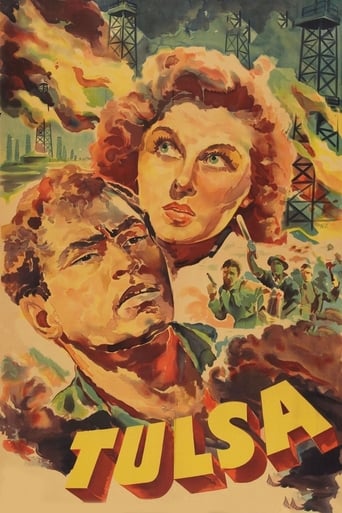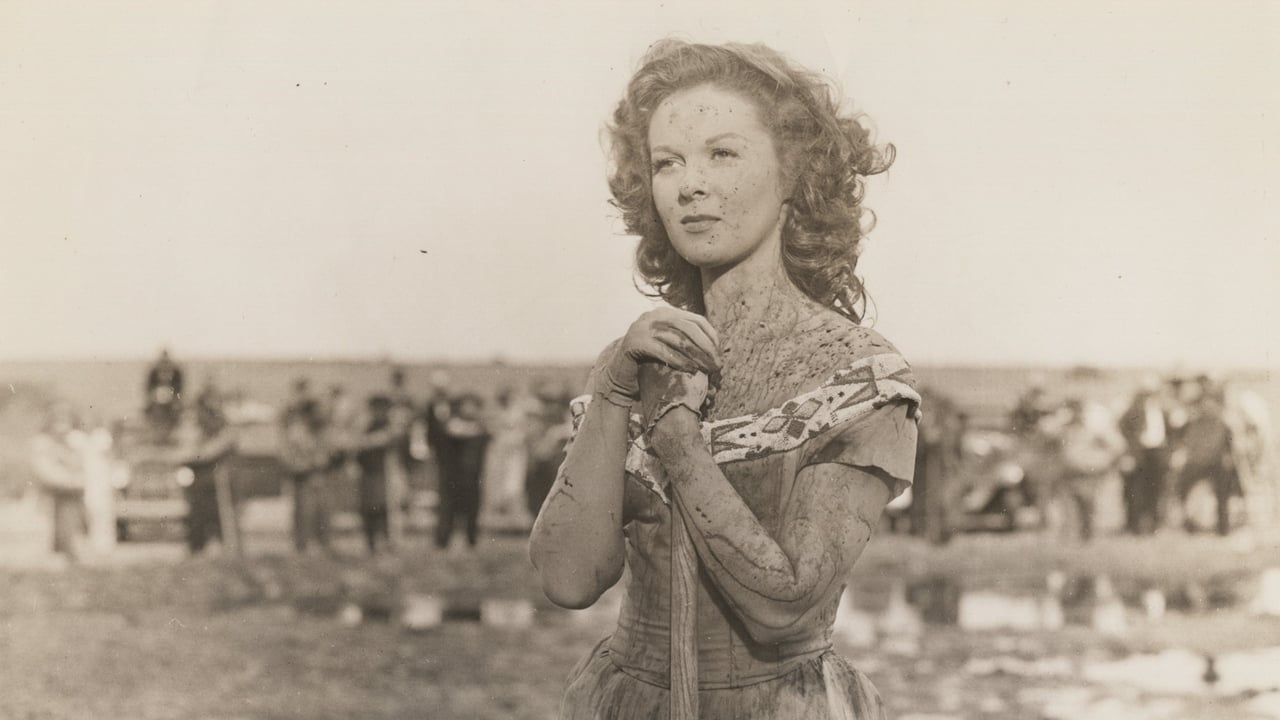JohnHowardReid
Copyright 13 April 1949 (in notice: 1948) by Pathe Industries, Inc. Released through Eagle Lion Films, Inc. in the U.S.A.; General Film Distributors - Eagle Lion in the U.K.; British Empire Films in Australia. New York opening at the Capitol: 26 May 1949. U.S. release: 13 April 1949. U.K. release: 1 August 1949. Australian release: 15 December 1949. 8,191 feet. 91 minutes.SYNOPSIS: Get-rich-quick oil tycoons win out over a lone conservation-minded cattleman in 1920s Oklahoma.NOTES: Eagle Lion's most expensive production was also its biggest box-office success, although by and large contemporary critics were not enthusiastic. Tulsa was nominated for an Academy Award for Best Special Effects, but in a two-picture poll came second to Mighty Joe Young.COMMENT: After a most unpromising start (Chill Wills ogling into the camera and giving us an earful of reach-me-down guff about oil and Tulsa and the great state of Oklahoma), this film picks up considerably as soon as the story starts. In fact, Tulsa is one of director Heisler's most entertaining features - and one of the few pictures in which his early training as a film editor is obviously evident. (Such scenes as the camera closing in on the Tanner sign with Hayward's face superimposed, followed by the long tracking shot as she makes her way through the hotel lobby, are most effectively contrived.)Susan Hayward never looked more attractive. Great care has been taken with her make-up and costumes, and even more importantly she has been glamorously lit and photographed from most flattering angles. What's more she has a typical Hayward role which she plays with her usual relish and drive.
Producer Wanger has surrounded his star with a competent array of support players. Armendariz is a little uncomfortable as "a crazy Indian", but Lloyd Gough is delightfully smooth as the chief villain and Ed Begley has an expressive cameo as a partying tycoon. Robert Preston plays the ruggedly honest hero with his usual ease and some of our favorite character players including Jimmy Conlin as Begley's reluctant attorney ("Never go anywhere without him!") are delightfully on hand.
Not only does the story move at a rapid pace and allow plenty of opportunities for conflict and drama (including a spectacularly fiery climax which was deservedly nominated for an Academy Award), but it is now very topically angled. Tulsa may well be the very first Hollywood feature primarily motivated by Pollution versus Conservation. The script's arguments are just as valid today as in 1948. What's more they are crisply presented in terms of human conflict, rather than the dry lessons of academics and pedants.By Eagle Lion standards, production values are extraordinarily lavish. Hoch's glamorous photography has already been commended, and this praise has to be extended to the sets and miniatures, the costumes and effects. And we're not complaining that Chill Wills sings the pat-on-the-back title song twice - he does it each time with such agreeable good humor.All in all, a most entertaining 90 minutes.
grizzledgeezer
...and that's fine by me! Most films about ecology have been cheap exploitation (eg, "Frogs"). This one is not. It's a moderately serious story about the need to use natural resources wisely. There's no question this is the reason the film was made. The script's seemingly accurate details suggest that someone did a lot of research about the oil industry."Tulsa" is also a good example of the principle that you can't tell stories about ideas, only people. Though exaggerated, the characterizations aren't too overdrawn, and we're willing to believe that Susan Hayward's character discards her principles in favor or money. (This is human nature -- unfortunately.) Similarly, Tanner //does not// change his beliefs at the end.Hayworth's performance is better-than-competent, and Robert Preston does a great job imitating Clark Gable. (Note the scene where the fully clothed Hayworth kisses Preston, dropping a gown she's holding, to suggest you-know what. It's a fine example of directors circumventing the Code.) The actors playing Indians at least //look like// Indians, rather than spray-painted whites.Though 65 years old, "Tulsa" has hardly dated. The issues at its center have still not been resolved -- nor have human beings developed better values.
wes-connors
In the "oil capital of the world" of Tulsa, Okalahoma, pretty red-haired Susan Hayward (as Cherokee "Cherry" Lansing) is devastated to witness the accidental death of her rancher father. Moreover, Ms. Hayward is denied $20,000 restitution for her father's crushing death, because the oil company says he was "trespassing". After inheriting some oil leases of her own, Hayward gets a chance to get even with the industry responsible for her dad's demise. With the help of tough oilman Robert Preston (Brad "Broncho" Brady), Hayward becomes the oil queen tycoon of Tulsa. Then, wealth and power threaten to corrupt Hayward's character...John Fulton's "Special Photographic Effects" were deservedly noted at the annual "Academy Awards"; the fiery Technicolor, and Hayward's "modeling" turns, are the film's main attractions. Walter Wanger's production of Richard Wormser's story has an admirable conservation message; however, it is bogged down by simplistic stereotypical predictability. Pedro Armendáriz (as Jim Redbird) does as well as he can in the contrived "brave Indian with a crazy streak" role. Lloyd Gough (as Bruce Tanner) is quite an effective human oil slick. And, gum-chewing "cousin" Chill Wills (as Pinky Jimpson) offers a most memorable "Will Rogers"-type characterization; he also narrates, and sings a nice title song.****** Tulsa (4/13/49) Stuart Heisler ~ Susan Hayward, Robert Preston, Chill Wills
weezeralfalfa
Susan Hayward and Robert Preston star in this story about a wildcat wildcatter. In my opinion, this is one of the most appropriate roles she did, considering her reported "sock it to em" personality. I don't understand why this film isn't better known and is not even mentioned in rundowns of Susan's major films. She plays the tough-as-nails Cherokee Lansing, part Native American daughter of a cattleman in the expanding oil country near Tulsa, OK, of the 1920s. She looks great, whether riding a horse around her cattle ranch or elegantly dressed in her mansion after becoming wealthy. Quite a few westerns dramatized the conflicts between cattlemen and sodbusters or between cattlemen and sheepherders in hillier terrain. This film explores the conflict between traditional cattle interests and emerging oil interests. Cherokee, herself, personifies this conflict as she transforms from an irate spokeswoman for the cattle interests into one of the leading promoters of oil interests, then backtracks, under pressure from her sometimes fiancé Brad Brady(Robert Preston) and her native American friend, Jim Redbird, to repromote a more balanced coexistence of oil and cattle interests. As often happens in such group conflict films, there is a disaster sequence, perpetrated by the established interests, to try to get rid of the invaders. In this case, it is a spectacular oil field fire, well done, although in reality, such a conflagration would have been practically impossible to extinguish with the technology of the 1920s. The perpetrator, Jim Redbird, could claim he was just trying to get rid of the oil slick that was killing his cattle, and that the fire just happened to spread to the adjacent oil field(It's not clear how?).This is at least the second film in which Susan was paired romantically with Robert Preston's character, the other being "Reap the Wild Wind". in which both die before the film is finished. Preston generally played supporting roles, often as wishy washy villains. Here, he does an excellent job as the top-billed male, Brad Brady. His relationship with his employer, Cherokee, undergoes a roller-coaster ride, starting very low and ending on a high note. The son of "Crude Oil" Johnny, who serendipitously signed his oil leases over to Cherokee just before being killed in a barroom brawl, Brady shows up unexpectedly at her drill site, fresh from a degree in petroleum engineering. He teams up with Jim Redbird in recommending a conservative approach to exploiting any oil found. In contrast, Bruce Tanner(Lloyd Gough), the reigning "oil king" of this region, wants to drill many wells and pump out the oil as fast as possible. At first, seen as an adversary by Cherokee, eventually, she agrees to cooperate and do things Tanner's way rather than Brady's way. Tanner even proposes marriage when he is thinking of running for governor, thus uniting the "oil king" and "oil queen". Jim Redbird also has romantic hopes with Cherokee. The oil field fire then becomes the focus. In the aftermath, Cherokee rethinks things and makes her final choice of policy and lover.This film invites comparisons with the previous film "Boomtown", staring Gable, Tracy, Colbert and Lamarr. They are both excellent stories in my opinion, relating to the development of oil fields and empires. Some viewers, no doubt, will strongly prefer one over the other. If you enjoyed this film, by all means check out "Boomtown" There are several obvious differences. Boomtown was shot in B&W versus Technicolor for "Tulsa". The featured wildcatters were Gable and Tracy and much of the movie deals with their up and down relationship and fortunes, somewhat similar to the up and down relationships between Cherokee and Brady, and Cherokee and Tanner, in the present film. "Boomtown" does not explore the dimension of conflict between cattlemen and oil developers. Both films end up promoting strategies for prolonged production rather than maximal short term production. They both include a spectacular oil field fire that threatens to destroy fortunes. Chill Wills, a native Oklahoman, is the only actor I know of who was in both films. In "Tulsa", he served as the occasional narrator and as a secondary acquaintance of Cherokee. He seemed to spend most of his time singing the title song "Tulsa" in a local club. Lloyd Gough serves as a charming, if sometimes double dealing, Bruce Tannner. His film career began late and was not very long.


 AD
AD


